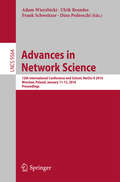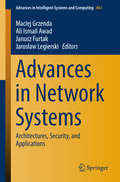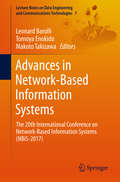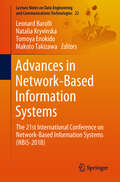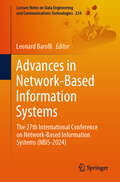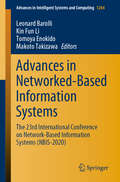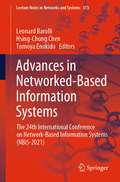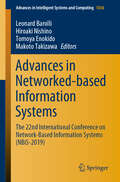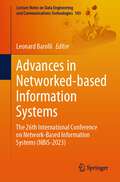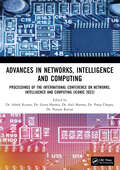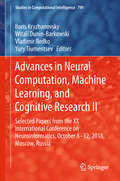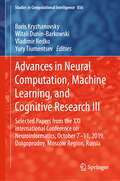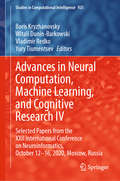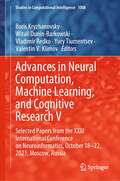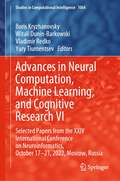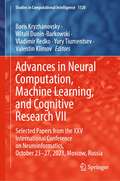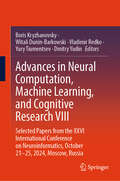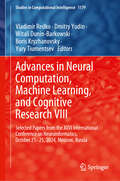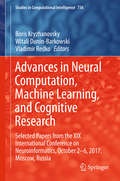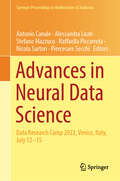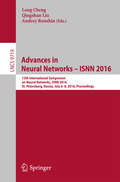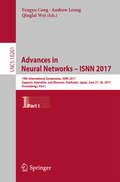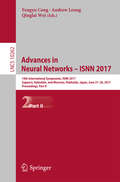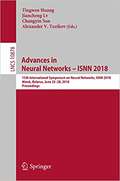- Table View
- List View
Advances in Network Science: 12th International Conference and School, NetSci-X 2016, Wroclaw, Poland, January 11-13, 2016, Proceedings (Lecture Notes in Computer Science #9564)
by Adam Wierzbicki Ulrik Brandes Frank Schweitzer Dino PedreschiThis bookconstitutes the refereed proceedings of the 12th International Conference andSchool of Network Science, NetSci-X 2016, held in Wroclaw, Poland, in January2016. The 12 fulland 6 short papers were carefully reviewed and selected from 59 submissions. The papers deal with the study of network models in domains ranging frombiology and physics to computer science, from financial markets to culturalintegration, and from social media to infectious diseases.
Advances in Network Systems: Architectures, Security, and Applications (Advances in Intelligent Systems and Computing #461)
by Ali Ismail Awad Maciej Grzenda Janusz Furtak Jarosław LegierskiThis book provides the reader with a comprehensive selection of cutting-edge algorithms, technologies, and applications. The volume offers new insights into a range of fundamentally important topics in network architectures, network security, and network applications. It serves as a reference for researchers and practitioners by featuring research contributions exemplifying research done in the field of network systems. In addition, the book highlights several key topics in both theoretical and practical aspects of networking. These include wireless sensor networks, performance of TCP connections in mobile networks, photonic data transport networks, security policies, credentials management, data encryption for network transmission, risk management, live TV services, and multicore energy harvesting in distributed systems.
Advances in Network-Based Information Systems: The 20th International Conference on Network-Based Information Systems (NBiS-2017) (Lecture Notes on Data Engineering and Communications Technologies #7)
by Makoto Takizawa Leonard Barolli Tomoya EnokidoThis book highlights the latest research findings, innovative research results, methods and development techniques from both theoretical and practical perspectives related to the emerging areas of information networking and their applications. It includes the Proceedings of the 20th International Conference on Network-Based Information Systems (NBiS-2017), held on August 24-26, 2017 in Toronto, Canada. Today's networks and information systems are evolving rapidly. Further, there are dynamic new trends and applications in information networking such as wireless sensor networks, ad hoc networks, peer-to-peer systems, vehicular networks, opportunistic networks, grid and c loud computing, pervasive and ubiquitous computing, multimedia systems, security, multi-agent systems, high-speed networks, and web-based systems. These networks are expected to manage the increasing number of users, provide support for a range of services, guarantee the quality of service (QoS), and optimize their network resources. In turn, these demands are the source of various research issues and challenges that have to be overcome - and which these Proceeding address.
Advances in Network-Based Information Systems: The 21st International Conference on Network-Based Information Systems (NBiS-2018) (Lecture Notes on Data Engineering and Communications Technologies #22)
by Makoto Takizawa Natalia Kryvinska Leonard Barolli Tomoya EnokidoThis book presents the latest research findings and innovative theoretical and practical research methods and development techniques related to the emerging areas of information networking and their applications. Today’s networks and information systems are evolving rapidly, and there are several new trends and applications, such as wireless sensor networks, ad hoc networks, peer-to-peer systems, vehicular networks, opportunistic networks, grid and cloud computing, pervasive and ubiquitous computing, multimedia systems, security, multi-agent systems, high-speed networks, and web-based systems. These networks have to deal with the increasing number of users, provide support for different services, guarantee the QoS, and optimize the network resources, and as such there are numerous research issues and challenges that need to be considered and addressed.
Advances in Network-Based Information Systems: The 25th International Conference on Network-Based Information Systems (NBiS-2022) (Lecture Notes in Networks and Systems #526)
by Leonard Barolli Tomoya Enokido Hiroyoshi MiwaThe networks and information systems of today are evolving rapidly. There are new trends and applications in information networking such as wireless sensor networks, ad hoc networks, peer-to-peer systems, vehicular networks, opportunistic networks, grid and cloud computing, pervasive and ubiquitous computing, multimedia systems, security, multi-agent systems, high-speed networks, and web-based systems. These kinds of networks need to manage the increasing number of users, provide support for different services, guarantee the QoS, and optimize the network resources. For these networks, there are many research issues and challenges that should be considered and find solutions. The aim of the book “Advances in Network-Based Information Systems” is to provide latest research findings, innovative research results, methods, and development techniques from both theoretical and practical perspectives related to the emerging areas of information networking and their applications.
Advances in Network-Based Information Systems: The 27th International Conference on Network-Based Information Systems (NBiS-2024) (Lecture Notes on Data Engineering and Communications Technologies #224)
by Leonard BarolliThe networks and information systems of today are evolving rapidly. There are new trends and applications in information networking such as wireless sensor networks, ad hoc networks, peer-to-peer systems, vehicular networks, opportunistic networks, grid and cloud computing, pervasive and ubiquitous computing, multimedia systems, security, multi-agent systems, high-speed networks, and web-based systems. These kinds of networks need to manage the increasing number of users, provide support for different services, guarantee the QoS, and optimize the network resources. For these networks, there are many research issues and challenges that should be considered and find solutions. The aim of the volume “Advances in Network-Based Information Systems” is to provide latest research findings, innovative research results, methods and development techniques from both theoretical and practical perspectives related to the emerging areas of information networking and their applications.
Advances in Networked-Based Information Systems: The 23rd International Conference On Network-based Information Systems (nbis-2020) (Advances In Intelligent Systems And Computing Series #1264)
by Makoto Takizawa Leonard Barolli Tomoya Enokido Kin Fun LiThis book aims to provide the latest research findings, innovative research results, methods, and development techniques from both theoretical and practical perspectives related to the emerging areas of information networking and their applications.The networks and information systems of today are evolving rapidly. There are new trends and applications in information networking such as wireless sensor networks, ad hoc networks, peer-to-peer systems, vehicular networks, opportunistic networks, grid and cloud computing, pervasive and ubiquitous computing, multimedia systems, security, multi-agent systems, high-speed networks, and web-based systems. These kinds of networks need to manage the increasing number of users, provide support for different services, guarantee the QoS, and optimize the network resources. For these networks, there are many research issues and challenges that should be considered and find solutions.
Advances in Networked-Based Information Systems: The 24th International Conference on Network-Based Information Systems (NBiS-2021) (Lecture Notes in Networks and Systems #313)
by Leonard Barolli Tomoya Enokido Hsing-Chung ChenThis book provides the latest research findings, innovative research results, methods and development techniques from both theoretical and practical perspectives related to the emerging areas of information networking and their applications. The networks and information systems of today are evolving rapidly. There are new trends and applications in information networking such as wireless sensor networks, ad hoc networks, peer-to-peer systems, vehicular networks, opportunistic networks, grid and cloud computing, pervasive and ubiquitous computing, multimedia systems, security, multi-agent systems, high-speed networks, and web-based systems. These kinds of networks need to manage the increasing number of users, provide support for different services, guarantee the QoS, and optimize the network resources. For these networks, there are many research issues and challenges that should be considered and find solutions.
Advances in Networked-based Information Systems: The 22nd International Conference on Network-Based Information Systems (NBiS-2019) (Advances in Intelligent Systems and Computing #1036)
by Makoto Takizawa Leonard Barolli Tomoya Enokido Hiroaki NishinoThis book focuses on the emerging areas of information networking and its applications, presenting the latest innovative research and development techniques from both theoretical and practical perspectives. Today’s networks and information systems are evolving rapidly, and there are new trends and applications in information networking, such as wireless sensor networks, ad hoc networks, peer-to-peer systems, vehicular networks, opportunistic networks, grid and cloud computing, pervasive and ubiquitous computing, multimedia systems, security, multi-agent systems, high-speed networks, and web-based systems. However, since these networks need to be capable of managing the increasing number of users, provide support for different services, guarantee the QoS, and optimize the network resources, a number of research issues and challenges have to be considered in order to provide solutions.
Advances in Networked-based Information Systems: The 26th International Conference on Network-Based Information Systems (NBiS-2023) (Lecture Notes on Data Engineering and Communications Technologies #183)
by Leonard BarolliThe networks and information systems of today are evolving rapidly. There are new trends and applications in information networking such as wireless sensor networks, ad hoc networks, peer-to-peer systems, vehicular networks, opportunistic networks, grid and cloud computing, pervasive and ubiquitous computing, multimedia systems, security, multi-agent systems, high-speed networks, and web-based systems. These kinds of networks need to manage the increasing number of users, provide support for different services, guarantee the QoS, and optimize the network resources. For these networks, there are many research issues and challenges that should be considered and find solutions. The aim of the book is to provide latest research findings, innovative research results, methods, and development techniques from both theoretical and practical perspectives related to the emerging areas of information networking and their applications.
Advances in Networks, Intelligence and Computing: Proceedings of the International Conference On Networks, Intelligence and Computing (ICONIC 2023)
by Ashok Kumar Anil Sharma Geeta Sharma Pooja Chopra Punam RattanThe year 2023 marks the 100th birth anniversary of E.F. Codd (19 August 1923 - 18 April 2003), a computer scientist, who while working for IBM invented the relational model for database management, the theoretical basis for relational databases and relational database management systems. He made other valuable contributions to computer science but the relational model, a very influential general theory of data management, remains his most mentioned, analyzed, and celebrated achievement. School of Computer Application, under the aegis of Lovely Professional University, pays homage to this great scientist of all times by hosting “CODD100 – International Conference on Networks, Intelligence and Computing (ICONIC-2023)”.
Advances in Neural Computation, Machine Learning, and Cognitive Research II: Selected Papers From The Xx International Conference On Neuroinformatics, October 8-12, 2018, Moscow, Russia (Studies in Computational Intelligence #799)
by Boris Kryzhanovsky Witali Dunin-Barkowski Vladimir Redko Yury TiumentsevThis book describes new theories and applications of artificial neural networks, with a special focus on addressing problems in neuroscience, biology and biophysics and cognitive research. It covers a wide range of methods and technologies, including deep neural networks, large-scale neural models, brain–computer interface, signal processing methods, as well as models of perception, studies on emotion recognition, self-organization and many more. The book includes both selected and invited papers presented at the XX International Conference on Neuroinformatics, held in Moscow, Russia on October 8–12, 2018.
Advances in Neural Computation, Machine Learning, and Cognitive Research III: Selected Papers from the XXI International Conference on Neuroinformatics, October 7-11, 2019, Dolgoprudny, Moscow Region, Russia (Studies in Computational Intelligence #856)
by Boris Kryzhanovsky Witali Dunin-Barkowski Vladimir Redko Yury TiumentsevThis book describes new theories and applications of artificial neural networks, with a special focus on answering questions in neuroscience, biology and biophysics and cognitive research. It covers a wide range of methods and technologies, including deep neural networks, large scale neural models, brain computer interface, signal processing methods, as well as models of perception, studies on emotion recognition, self-organization and many more. The book includes both selected and invited papers presented at the XXI International Conference on Neuroinformatics, held on October 7-11, 2019, in Dolgoprudny, a town in Moscow region, Russia.
Advances in Neural Computation, Machine Learning, and Cognitive Research IV: Selected Papers from the XXII International Conference on Neuroinformatics, October 12-16, 2020, Moscow, Russia (Studies in Computational Intelligence #925)
by Boris Kryzhanovsky Witali Dunin-Barkowski Vladimir Redko Yury TiumentsevThis book describes new theories and applications of artificial neural networks, with a special focus on answering questions in neuroscience, biology and biophysics and cognitive research. It covers a wide range of methods and technologies, including deep neural networks, large scale neural models, brain computer interface, signal processing methods, as well as models of perception, studies on emotion recognition, self-organization and many more. The book includes both selected and invited papers presented at the XXII International Conference on Neuroinformatics, held on October 12-16, 2020, Moscow, Russia.
Advances in Neural Computation, Machine Learning, and Cognitive Research V: Selected Papers from the XXIII International Conference on Neuroinformatics, October 18-22, 2021, Moscow, Russia (Studies in Computational Intelligence #1008)
by Valentin V. Klimov Boris Kryzhanovsky Witali Dunin-Barkowski Vladimir Redko Yury TiumentsevThis book describes new theories and applications of artificial neural networks, with a special focus on answering questions in neuroscience, biology and biophysics and cognitive research. It covers a wide range of methods and technologies, including deep neural networks, large scale neural models, brain computer interface, signal processing methods, as well as models of perception, studies on emotion recognition, self-organization and many more. The book includes both selected and invited papers presented at the XXIII International Conference on Neuroinformatics, held on October 18-22, 2021, Moscow, Russia.
Advances in Neural Computation, Machine Learning, and Cognitive Research VI: Selected Papers from the XXIV International Conference on Neuroinformatics, October 17-21, 2022, Moscow, Russia (Studies in Computational Intelligence #1064)
by Boris Kryzhanovsky Witali Dunin-Barkowski Vladimir Redko Yury TiumentsevThis book describes new theories and applications of artificial neural networks, with a special focus on answering questions in neuroscience, biology and biophysics and cognitive research. It covers a wide range of methods and technologies, including deep neural networks, large-scale neural models, brain–computer interface, signal processing methods, as well as models of perception, studies on emotion recognition, self-organization and many more. The book includes both selected and invited papers presented at the XXIV International Conference on Neuroinformatics, held on October 17–21, 2022, in Moscow, Russia.
Advances in Neural Computation, Machine Learning, and Cognitive Research VII: Selected Papers from the XXV International Conference on Neuroinformatics, October 23-27, 2023, Moscow, Russia (Studies in Computational Intelligence #1120)
by Boris Kryzhanovsky Witali Dunin-Barkowski Vladimir Redko Yury Tiumentsev Valentin KlimovThis book describes new theories and applications of artificial neural networks, with a special focus on answering questions in neuroscience, biology and biophysics and cognitive research. It covers a wide range of methods and technologies, including deep neural networks, large-scale neural models, brain–computer interface, signal processing methods, as well as models of perception, studies on emotion recognition, self-organization and many more. The book includes both selected and invited papers presented at the XXV International Conference on Neuroinformatics, held on October 23-27, 2023, in Moscow, Russia.
Advances in Neural Computation, Machine Learning, and Cognitive Research VIII: Selected Papers from the XXVI International Conference on Neuroinformatics, October 21-25, 2024, Moscow, Russia
by Boris Kryzhanovsky Witali Dunin-Barkowski Vladimir Redko Yury Tiumentsev Dmitry YudinThis book describes new theories and applications of artificial neural networks, with a special focus on answering questions in neuroscience, biology and biophysics and cognitive research. It covers a wide range of methods and technologies, including deep neural networks, large-scale neural models, brain–computer interface, signal processing methods, as well as models of perception, studies on emotion recognition, self-organization and many more. The book includes both selected and invited papers presented at the XXVI International Conference on Neuroinformatics, held on October 21–25, 2024, in Moscow, Russia.
Advances in Neural Computation, Machine Learning, and Cognitive Research VIII: Selected Papers from the XXVI International Conference on Neuroinformatics, October 21-25, 2024, Moscow, Russia (Studies in Computational Intelligence #1179)
by Boris Kryzhanovsky Witali Dunin-Barkowski Vladimir Redko Yury Tiumentsev Dmitry YudinThis book describes new theories and applications of artificial neural networks, with a special focus on answering questions in neuroscience, biology and biophysics and cognitive research. It covers a wide range of methods and technologies, including deep neural networks, large-scale neural models, brain–computer interface, signal processing methods, as well as models of perception, studies on emotion recognition, self-organization and many more. The book includes both selected and invited papers presented at the XXVI International Conference on Neuroinformatics, held on October 21–25, 2024, in Moscow, Russia.
Advances in Neural Computation, Machine Learning, and Cognitive Research: Selected Papers from the XIX International Conference on Neuroinformatics, October 2-6, 2017, Moscow, Russia (Studies in Computational Intelligence #736)
by Boris Kryzhanovsky Witali Dunin-Barkowski Vladimir RedkoThis book describes new theories and applications of artificial neural networks, with a special focus on neural computation, cognitive science and machine learning. It discusses cutting-edge research at the intersection between different fields, from topics such as cognition and behavior, motivation and emotions, to neurocomputing, deep learning, classification and clustering. Further topics include signal processing methods, robotics and neurobionics, and computer vision alike. The book includes selected papers from the XIX International Conference on Neuroinformatics, held on October 2-6, 2017, in Moscow, Russia.
Advances in Neural Data Science: Data Research Camp 2022, Venice, Italy, July 12–15 (Springer Proceedings in Mathematics & Statistics #475)
by Piercesare Secchi Antonio Canale Nicola Sartori Stefano Mazzuco Alessandra Luati Raffaella PiccarretaThis proceeding volume will contain a collection of peer-reviewed articles arising from the Data Research Camp 2022. The workshop took place on July 12–15, 2022, at the Venice International University, in the venetian island of San Servolo. The Data Research Camp has been a stimulating experience bringing together 28 early-career researchers in statistics and seven international professors with the common task of developing novel statistical methods for complex brain imaging data. The workshop was motivated by the recent advancements in miniaturized fluorescence microscopy that have made it possible to collect complex data on neuronal responses to stimuli in awake behaving animals. Several ongoing challenges are related to this novel technology including the deconvolution of the temporal signals to extract the spike trains from the noisy calcium data, the estimation of neuronal activation intensity distribution, the spatio-temporal dependence or covariate effect estimation, among others.
Advances in Neural Networks - ISNN 2016: 13th International Symposium on Neural Networks, ISNN 2016, St. Petersburg, Russia, July 6-8, 2016, Proceedings (Lecture Notes in Computer Science #9719)
by Andrey Ronzhin Qingshan Liu Long ChengThis book constitutes the refereed proceedings of the 13th International Symposium on Neural Networks, ISNN 2016, held in St. Petersburg, Russia in July 2016. The 84 revised full papers presented in this volume were carefully reviewed and selected from 104 submissions. The papers cover many topics of neural network-related research including signal and image processing; dynamical behaviors of recurrent neural networks; intelligent control; clustering, classification, modeling, and forecasting; evolutionary computation; and cognition computation and spiking neural networks.
Advances in Neural Networks - ISNN 2017: 14th International Symposium, ISNN 2017, Sapporo, Hakodate, and Muroran, Hokkaido, Japan, June 21–26, 2017, Proceedings, Part I (Lecture Notes in Computer Science #10261)
by Qinglai Wei Fengyu Cong Andrew LeungThis book constitutes the refereed proceedings of the 14th International Symposium on Neural Networks, ISNN 2017, held in Sapporo, Hakodate, and Muroran, Hokkaido, Japan, in June 2017. The 135 revised full papers presented in this two-volume set were carefully reviewed and selected from 259 submissions. The papers cover topics like perception, emotion and development, action and motor control, attractor and associative memory, neurodynamics, complex systems, and chaos.
Advances in Neural Networks - ISNN 2017: 14th International Symposium, ISNN 2017, Sapporo, Hakodate, and Muroran, Hokkaido, Japan, June 21–26, 2017, Proceedings, Part II (Lecture Notes in Computer Science #10262)
by Qinglai Wei Fengyu Cong Andrew LeungThis book constitutes the refereed proceedings of the 14th International Symposium on Neural Networks, ISNN 2017, held in Sapporo, Hakodate, and Muroran, Hokkaido, Japan, in June 2017. The 135 revised full papers presented in this two-volume set were carefully reviewed and selected from 259 submissions. The papers cover topics like perception, emotion and development, action and motor control, attractor and associative memory, neurodynamics, complex systems, and chaos.
Advances in Neural Networks – ISNN 2018: 15th International Symposium On Neural Networks, ISNN 2018, Minsk, Belarus, June 25-28, 2018, Proceedings (Theoretical Computer Science and General Issues #10878)
by Tingwen Huang Jiancheng Lv Changyin Sun Alexander V. TuzikovThis book constitutes the refereed proceedings of the 15th International Symposium on Neural Networks, ISNN 2018, held in Minsk, Belarus in June 2018.The 98 revised regular papers presented in this volume were carefully reviewed and selected from 214 submissions. The papers cover many topics of neural network-related research including intelligent control, neurodynamic analysis, bio-signal, bioinformatics and biomedical engineering, clustering, classification, forecasting, models, algorithms, cognitive computation, machine learning, and optimization.
